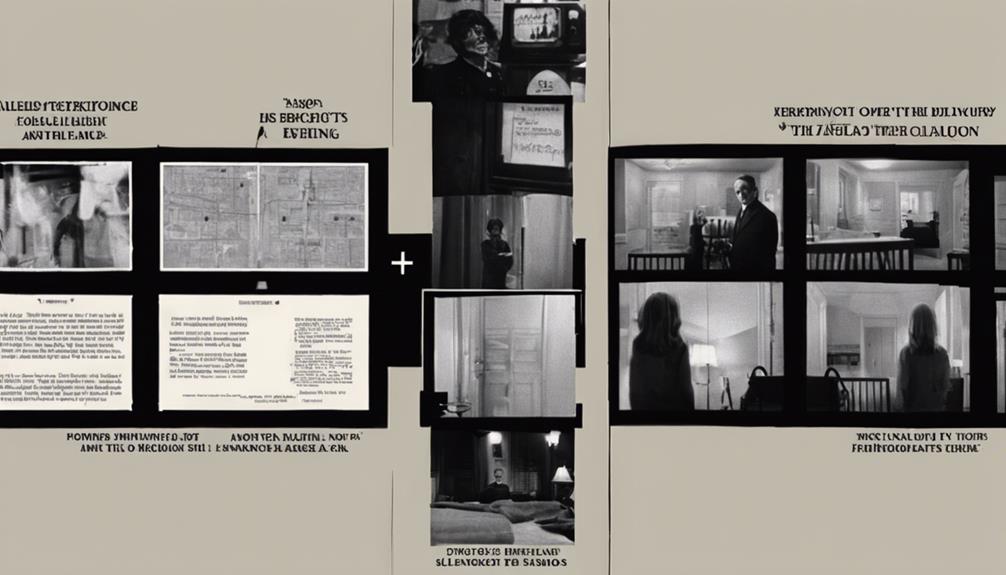Subliminal messages in 'The Exorcist' intensify fear and psychological manipulation themes. Quick flashes of unsettling imagery and eerie sounds provoke unease by targeting the subconscious. These hidden cues add complexity and depth to the narrative, creating an immersive and chilling viewing experience. Alleged subliminal messages in the film contain layers of symbolic imagery and auditory cues to engage audiences emotionally. They shape perceptions, enhance suspense, and guide specific audience reactions. The impact on viewers raises ethical debates on manipulation and audience manipulation boundaries. The use of subliminal messages in 'The Exorcist' is a fascinating aspect worth exploring further.
The Exorcist Subliminal Messages: What Are They?

The subliminal messages present in the iconic horror film 'The Exorcist' subtly convey themes of fear and psychological manipulation to the audience. Hidden meanings within the film serve to enhance the overall viewing experience by tapping into the subconscious mind of the viewer.
Through quick flashes of disturbing imagery and eerie sounds, the film creates a sense of unease and tension that lingers long after the movie has ended.
These subliminal messages are strategically placed throughout the film to evoke strong psychological effects on the audience. By bypassing the conscious mind and targeting the subconscious, these hidden cues can instill deep-seated fears and anxieties within the viewers.
The use of subliminal messages in 'The Exorcist' adds layers of complexity to the narrative, creating a more immersive and unsettling viewing experience for those who are attentive enough to catch these fleeting moments.
The History of Subliminal Messages in Film
Subliminal messages in film have a rich history that spans decades, with various filmmakers and studios exploring the psychological impact of hidden cues on audiences.
The concept of subliminal messages dates back to the late 1950s when researchers began studying the effects of subliminal advertising on consumer behavior. This led to a wave of controversy surrounding the use of subliminal techniques in various media, including film.
Subliminal advertising, a form of hidden messaging intended to persuade viewers without their conscious awareness, raised ethical concerns about manipulation and the potential to exploit vulnerable audiences.
Despite the lack of concrete evidence supporting the effectiveness of subliminal messaging, its presence in films continued to intrigue both filmmakers and audiences alike.
The psychological effects of subliminal messages in film remain a topic of debate, with some arguing that subtle cues can influence perceptions and behaviors, while others dismiss their impact as negligible.
Regardless of the ongoing controversy, the exploration of subliminal techniques in cinema highlights the enduring fascination with the intersection of psychology and persuasion in filmmaking.
Analyzing Alleged Subliminal Messages in The Exorcist

An examination of the alleged subliminal messages in 'The Exorcist' reveals intriguing layers of visual and auditory cues embedded within the film. Symbolic imagery plays a significant role in conveying hidden meanings throughout the movie. From the use of religious symbols to subtle visual cues hinting at the protagonist's internal struggles, 'The Exorcist' employs a range of symbolic imagery to engage the audience on a deeper level.
Moreover, the film utilizes psychological manipulation techniques to evoke specific audience reactions. The incorporation of quick flashes of unsettling images or eerie sounds serves to create a sense of unease and suspense, heightening the overall viewing experience.
These subliminal elements are strategically woven into the narrative to elicit emotional responses and immerse viewers in the chilling atmosphere of the film.
Impact on Audience Perception and Experience
Through the strategic integration of subliminal messages, 'The Exorcist' cultivates a transformative viewing experience that shapes audience perceptions and heightens emotional engagement.
Subliminal messaging in film production can have profound psychological effects on viewers, influencing their interpretation of the narrative and characters. In 'The Exorcist', subtle images and sounds strategically woven into the film can evoke fear, unease, and suspense, intensifying the audience's emotional response to the horror depicted on screen.
These subliminal elements can subconsciously impact audience interpretation, guiding them towards specific emotions or conclusions without their conscious awareness.
By manipulating visual and auditory cues at a subconscious level, filmmakers can enhance the overall viewing experience, making it more immersive and visceral for the audience.
The psychological effects of subliminal messaging in 'The Exorcist' contribute to its reputation as a groundbreaking horror film that continues to captivate and disturb viewers decades after its release.
Debunking the Myth: Fact or Fiction?

Questions have arisen surrounding the validity of claims regarding subliminal messages in 'The Exorcist,' prompting an examination of whether these assertions hold up under scrutiny. Myth busting in this scenario focuses on allegations that hidden messages were deliberately inserted into the film to evoke specific psychological effects in viewers. However, research suggests that the human brain may not be as susceptible to subliminal messaging as once thought.
Studies have indicated that while subliminal stimuli can influence perception and behavior to some extent, the effects are generally subtle and short-lived.
Moreover, the idea of subliminal messages being strategically placed in 'The Exorcist' to enhance its frightening impact may be more fiction than fact. The film's ability to evoke fear and unease in audiences can be attributed to a combination of factors such as its eerie atmosphere, shocking visuals, and compelling storytelling, rather than any hidden messages.
In this scenario, the notion of subliminal messages playing a significant role in shaping viewers' experiences of 'The Exorcist' may be more of a myth than a reality.
Ethical Considerations and Controversies
Exploring the ethical implications and controversies surrounding subliminal messages in media raises important considerations for both creators and consumers alike. The use of subliminal messages in media content has sparked debates about the ethical boundaries of manipulating individuals' perceptions without their conscious awareness. Critics argue that such practices raise concerns about the potential psychological effects on viewers and the ethical implications of using subliminal messaging as a tool for manipulation.
One of the key controversies surrounding subliminal messages is the extent to which they can influence individuals' thoughts, emotions, and behaviors without their explicit consent. This raises questions about the ethical responsibility of creators to prioritize the well-being of their audience over potentially manipulative tactics.
Additionally, the blurred line between subtle persuasion and outright manipulation adds complexity to the ethical considerations surrounding the use of subliminal messages in media.
Conclusion
To wrap up, the presence of subliminal messages in The Exorcist raises thought-provoking questions about the impact of such techniques on audience perception.
While the discussion persists regarding the validity of these supposed messages, the controversy surrounding them adds a layer of fascination to the film.
It is crucial to ponder the ethical implications of incorporating subliminal messages in media and the possible effects they may have on viewers.
The Exorcist remains a captivating case study in the domain of subliminal messaging in film.
Dr. John Renoldson is a distinguished professor of Clinical Research Hypnotherapy He holds a PhD in Clinical Psychology and specializes in hypnotherapy and scientific research to enhance therapeutic outcomes. Dr. Renoldson has authored numerous peer-reviewed articles on the efficacy of hypnosis in treating conditions.




